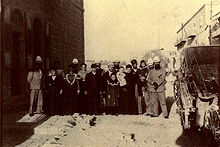When Shmuel and I decided to do the Burma Road hike which is a 30 minute drive from Jerusalem and Tel Aviv, we realized we had three choices – hike, jeep trek, or even a bus tour. We decided to go on foot for part of it with a group, and tagged along quietly to see what there was to be seen.
We started at the Harel Outpost, the building that served as HQ for Palmach and Machal command for part of the war of Independence. The guide explained the message from David Ben Gurion, known as the "order of the day", given on the eve of the breaking of the siege of Jerusalem. The message: "Jerusalem at any Cost". Ben Gurion went on to order the troops to break through to Jerusalem with the understanding that it was inconceivable that the new State of Israel would be left without Jerusalem as its capital city.
Just north of the building, we walked over to a topographic model of Burma Road, overlooking the Latrun Tank Museum, the Latrun Monastery and the village of Neve Shalom. We could see the models of the young soldiers on the hill in the distance, marching through the wheat fields. We took a closer look at the mosaic and dynamic of life, living and community in Israel. The Monastery, the army base and the Jewish / Muslim village of Neve Shalom, all situated on the same hillside area.
As we walked down the path on the Burma Road, we stopped to view the pictures of Machal volunteers and Palmach soldiers along the route and took a look at the faces of the young soldiers, many of whom were teens, just having arrived as survivors of the destruction of European Jewry, now taking on the role of defenders of Jerusalem. Young men and women in the pictures along the route, some of whom looked just like we in our group did.
We saw the orchards along the route. Olive groves, planted pine trees, apricots, etc. Suddenly, at the bottom of the hill as we continued east on the road, we came upon taller palm trees, with a dried up brook (nahal) in the middle. It was the site of the abandoned Arab village of Ein Sussin, one of hundreds of villages abandoned during the War of Independence (termed "Nakba" or catastrophe by Palestinians), where we discussed the issue of who these people were, what happened to their village, and the roots of the Palestinian refugee issue.
We finished with coffee on the fire and marshmallows while listening to Palmach stories. Our guide pulled out her guitar and we sang folk songs of early Israel. The theme was "Jerusalem at any Cost" and the centrality of Jerusalem (City of Peace) to the Jewish experience and the Jewish People. We discussed the issue of volunteers from abroad (Machal Unit in the IDF) who came to take part in the battle for sovereignty and independence in the Land of Israel. The relationship between Jewish People in the Diaspora and Jews in Israel is one that is all about Jewish Peoplehood, our national identity(s). This partnership between Israel and the Jewish Diaspora has been in place since the very beginning.
~~~~~~~~~~~
IsraelExperts is a fully-licensed Israel tour operator; our head office is in Israel. Comprised of experienced Israel destination professionals, logistics experts, informal educators and accredited tour guides, IsraelExperts works with major organizations around the world in the field of Israel-Diaspora relations and Israel education, and offers you its ability to provide quality innovative programs. You can find us on line at www.israelexperts.com or email us at info@israelexperts.com for more information.












